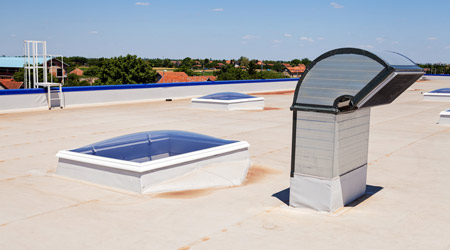Three Fundamentals of Good Single-Ply Roofing
Part 1 of a 2-part article exploring what's required for single-ply roofing success.
Given all the factors involved in getting a good single-ply roof, there may be times when facility managers feel a bit like Alice wandering through Wonderland.
“Would you tell me, please, which way I ought to go from here?” asked Alice.
“That depends a good deal on where you want to get to,” said the (Cheshire) Cat.
If you’re considering single-ply roofing options, you likely know in a general sense where you want to go: The aim is to get a good roof. The question is, are you following the right path? As the Cheshire Cat says, if you have no direction, you will eventually get somewhere, but it may not be where you wanted to end up. So it is in roofing.
It’s understandable to feel a little lost, given all the factors to consider in selecting the right single-ply roof. A one-story building in a suburban area will allow attachment methods that would be unacceptable if used on a high-rise roof in a high-wind zone. A dark-colored roof in a hot climate will add to air-conditioning loads and increase the cost of running the building, so a light-colored PVC, KEE, or TPO may be the best fit. However, where heating days outnumber cooling days or where the building is subject to high temperature swings, a more flexible, darker membrane such as an EPDM may be the most appropriate choice. An almost inaccessible roof may dictate a membrane that is easily transportable and installable, like a peel-and-stick membrane.
Rural buildings may suffer from a lack of qualified applicators for the less-used single-ply membrane roof systems, making the more universally installed TPO, PVC, and EPDM the better options. The costs of shipping membranes to out-of-the way locales can drastically affect pricing, and the effect of the transportation on greenhouse gas emissions may mean you want to make a more environmentally responsible choice. The combination of factors, if properly considered when designing the roof, will eventually result in the choice of the most appropriate membrane and the first step toward a great roof.
In getting a good single-ply roof, many factors require attention. For example:
• Physical characteristics of the building including height, floor plate, location on the site, access to the roof, type and slope of deck, amount of equipment on roof and its location, drainage, and even the elevator’s availability, load capacity, and size.
• Climate — wind, rain, snow, hail, heat, cold, wide temperature swings.
• Location-specific factors such as ease of access and availability of materials and qualified applicators.
• Use of the building.
• Governmental requirements including building and fire codes, zoning laws, and even local ordinances that may affect appearance, working hours, and noise reduction.
• Sustainability and environmental issues.
So how does one assure a good single-ply roof? There are three things to pay attention to: design, installation, and maintenance.
1. Good Design
The first major factor is roof design. The key considerations here include:
• Choose the correct color membrane for the building. A rule of thumb is to use a darker-colored membrane when heating days exceed cooling days and a lighter one when the opposite is true.
• When the roof is over wide open spaces, choose a wider membrane. This requires fewer seams than a narrower membrane. Because the most vulnerable part of a single-ply membrane is the seaming, a roof with fewer seams is generally better.
• Pick the insulation or direct membrane attachment method best suited to the deck type. Single plies are most commonly installed using screws and plates — sometimes over and sometimes under the membrane. Mechanical attachments — screws and plates — are better for wood, lightweight concrete, cementitious wood fiber, gypsum, and steel decks. In many cases, adhesives can also be used on these decks, depending on the roof that is being installed. A concrete deck lends itself best to adhesives. Regardless of the attachment method, a deteriorated deck will cause problems, so it is mandatory to require the contractor to replace any areas of deck deteriorated to the point where a fastener will not properly hold, and areas that are damp to the point that the adhesive will not stick.
• Choose a system that fits the building’s use. A sturdier system that resists punctures is more appropriate for roofs subject to abuse, such as schools. A restaurant that spews greasy residue on the roof is not appropriate for a system that is deteriorated by hydrocarbon products. A membrane that is more resistant to deterioration from standing water is better for a place where the drainage is inadequate and not easily remedied by sloping insulation or the addition of new drains.
• The termination of the roof becomes even more important in a single-ply membrane system. Be sure the metal termination method is appropriate for the wind conditions. Saltwater exposure and high humidity make the corrosion-resistance of the edge metals very important.
• Be sure the membrane is properly supported by a hard substrate, especially where hail or foot traffic is common. A soft substrate can allow the membrane to be more easily damaged as the soft substrate will depress so that the hail can penetrate.
• If all else is equal, choose a membrane that is readily available in the area and for which qualified contractors are available nearby.
• Together, the specifications and drawings form the contract documents that allow bidders to all bid on the same scope of work. More importantly, during installation your quality-assurance inspector can use these documents to compare what is being installed to what you’re paying for to be sure the roof is being installed according to contract.
Related Topics:













